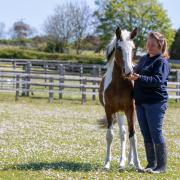Chickens are all the rage, with an estimated 500,000 people across the country now keeping birds in their back garden or yard. They are also chic!

Numerous celebrities have started keeping chickens, here Charlotte Popescu helps you get started:

I have kept hens in our garden for the past 17 years and I can promise you that they make wonderful pets with the bonus of their lovely eggs; they will give you great pleasure and endless amusement as each hen has her own individual character. Apart from making nests and laying eggs, hens love to exercise, flap their wings, preen, dust-bathe, sunbathe, scratch, peck and forage for food, as well as perch off the ground during the day, especially if it is wet.
Hen keeping has grown enormously in popularity over the past few years and, with recent hikes in supermarket egg prices, more and more people are likely to opt for their own hens in the garden. You don’t need a cockerel in order for your hens to lay eggs.
Starting with three or four hybrid hens is a good idea; you should buy them at POL, Point of Lay (18 – 22 weeks), which means they are ready to start laying. Hybrids have been specifically developed to lay lots of eggs and will be friendly and docile. Isa Warrens, Black Rocks, Amber Stars, Bluebelles and Speckledys are some of the hybrids on offer. Alternatively you could go for some pure breeds such as Rhode Island Reds, Marans, Welsummers or Sussex or for some bantams such as the cuddly, feather-legged Pekins or Wyandottes (which are attractive, need less space, eat less food and may do less damage in the garden). Go to a reputable breeder and see your hens before you buy them; ask to see the parent stock if you are going for pure breeds.
Healthy hens will be alert with red combs, if they are already laying, and erect tails. Ask if they have been vaccinated and wormed. You could go to a poultry show or visit a few breeders who have both hybrids and pure breeds so that you can see the many varieties on offer. If you decide on hybrids you can find various companies through a search on the internet.
Magazines such as Your Chickens or Country Smallholding contain a useful breeders’ directory. It is best to avoid bidding at markets as you will have no idea where the hens have come from and whether they are healthy; you may also end up with young cockerels.
You will need a secure hen house which must be ventilated and weatherproof with perches and nest boxes. You can use shavings or straw to line the nest boxes and as bedding on the floor.
As a general rule, a minimum outside space for three chickens is 3.6m x 4.8m, but give your hens as large an area as possible, with shade from the sun and somewhere to shelter from the wind and rain and grass to roam on and peck at. Free range hens will give you the best deep yellow egg yolks. Your hens will need a patch of bare earth or a shallow box filled with earth in which to dust-bathe.
You may opt to enclose your hens in a run; you should make it fox-proof by burying 1.8m fences at least 30cm into the ground or use electric fencing. If you’re a city dweller you may have less space; arks which attach to hen houses are a good idea since they are on wheels and can be moved to fresh grass.
You’ll need a drinker filled with fresh, clean water, a feeder, and layers pellets and/or mixed poultry corn. If your hens are enclosed give them as much green stuff as you can but also mixed grit with oystershell. The grit goes into the gizzard and is used to grind up the corn and pellets (hens have no teeth) and the oystershell provides calcium for egg shells. Your hens will eat grass and weeds, as well as worms and garden pests such as slugs, snails, woodlice, earwigs and ants.
Remember, all hens moult in the late Summer/Autumn and they will stop laying at this time.
Once a routine is established with your new hens you’ll find maintenance easy – the least you need to do is to let them out in the morning, making sure they have food and water, collect the eggs and shut them up in the evening.
Costs
I estimate that the set-up costs for your hens, with a basic coop and accessories, will be around £250 minimum.
Your hen house will be your largest investment; coops can cost between £150 for a cheap, basic type to £1,000 for a hen palace! You will need to spend at least £300 for a well-made coop and run. You may need to spend extra on fencing to ensure your hens are safe from predators.
A basic plastic drinker and feeder will set you back around £10. Your hens will cost in the region of £15 per hybrid, but if you go for pure breeds you may pay around £30 for a POL hen or more if you go for a rare breed or colour; bantams will be a little cheaper at around £15-20 each. Younger hens can be cheaper (breeders raise the price week by week until POL).
Feed costs are escalating (due to poor crop harvests last year) and layers pellets are now around £10 for 20kg. Mixed poultry corn is around £8 for 20 kg.
You will also need to buy bedding and mixed grit with oystershell.
Author:
Charlotte Popescu is the author of several chicken related books:
For more details see www.cavalierpaperbacks.co.ukMagazines: Your Chickens. Specifically aimed at back garden hen keepers, with lots of advice from experts as well as features and news: www.yourchickens.co.uk Country Smallholding: www.countrysmallholding.com
Like what you’ve read, why not try three issues of Your Chickens for just £3? Visit www.subscriptionsave.co.uk/SYC or call 0844 848 8056 quoting LYCSOL14



























